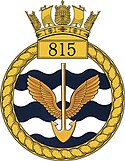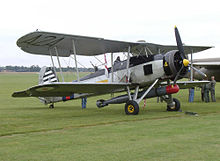815 Naval Air Squadron
| 815 Naval Air Squadron | |
|---|---|
 Official 815 Naval Air Squadron Badge | |
| Active | Oct–Nov 1939 Nov 1939 – Jul 1943 Oct 1943 – Nov 1944 Dec 1944 – 1945 1947 – July 1958 Sep 1958 – Aug 1959 Sep 1959 – Dec 1960 Jul 1961 – Oct 1966 Jan 1981 – present |
| Country | |
| Branch | |
| Type | Naval Air Squadron |
| Role | Maritime Attack |
| Part of | Fleet Air Arm |
| Garrison/HQ | RNAS Yeovilton (HMS Heron) |
| Motto(s) | Strike Deep |
| Equipment | AgustaWestland Wildcat HMA.2 |
| Battle honours | North Sea 1940 Mediterranean 1940–42 Taranto 1940 Libya 1941–42 Matapan 1941 Burma 1944 East Indies 1944 Falkland Islands 1982 Kuwait 1991[1] |
| Commanders | |
| Current commander | Cdr Russ Clarke RN |
| Ceremonial chief | The Duke of Edinburgh |
815 Naval Air Squadron is a squadron of the Fleet Air Arm, part of the Royal Navy, based at RNAS Yeovilton (HMS Heron) in Somerset; it is the Navy's front line Wildcat Naval Air Squadron. It comprises AgustaWestland Wildcat HMA.2 helicopters and is the largest helicopter squadron in western Europe.[2]
History[]
Second World War[]


The squadron formed at RNAS Worthy Down on 9 October 1939, from the remnants of 811 and 822 squadrons that had survived the sinking of their carrier HMS Courageous in September 1939, with Fairey Swordfish aircraft.[3] The squadron disbanded in November 1939 but reformed the same month.[3] In May 1940 the squadron provided support to the Dunkirk evacuation.[3] In June 1940, the squadron embarked on HMS Illustrious and sailed for the Mediterranean in August, attacking and minelaying Benghazi, Rhodes and Tobruk.[3] The squadron gained early fame with its involvement in the Battle of Taranto in 1940, when the Italian Battlefleet in harbour at Taranto was raided; which redefined the use of air power from the sea. The aircraft of the commanding officer was lost, against the crippling of half the Italian fleet.[3] In March 1941, the squadron fought in the Battle of Cape Matapan. The squadron re-equipped in August 1941, with a mixture of Swordfish and Fairey Albacore aircraft, operating from shore bases in support of the North African campaign.[3] In July 1943, 815 Squadron was assigned to No. 201 (Naval Co-operation) Group with a detachment of Swordfish assigned to AHQ Malta; the units participating in Operation Husky on 10 July 1943, before 815 Squadron was disbanded.
On Fairey Barracudas[]

The squadron reformed in October 1943 at RNAS Lee-on-Solent (HMS Daedalus) to operate Fairey Barracuda torpedo bombers, operating from Indomitable with the Eastern Fleet, attacking targets in Sumatra, August–September 1944.[4] In November 1944 the squadron disbanded and reformed in December at RNAS Machrihanish (HMS Landrail), flying Barracudas for anti-submarine operations, the following month being spent doing DLT (deck landing training) on HMS Campania.[3] The squadron was transferred to the Far East aboard HMS Smiter but saw no action before VJ-Day and returned to the UK in September 1945 aboard HMS Fencer.[3]
Post war[]
Avenger and Gannet[]


The squadron disbanded some time after the war and reformed in 1947 from 744 Squadron, flying Grumman Avengers, which were replaced with Fairey Gannets, the last fixed-wing aircraft of the squadron when it disbanded at RNAS Culdrose (HMS Seahawk), July 1958.[5]
Westland Whirlwind[]
In September 1958, the squadron reformed on Westland Whirlwind HAS.7 helicopters, moving to RNAS Portland (HMS Osprey) when engine trouble started to plague the Whirlwinds. The squadron eventually disbanded here on August 1959 by being renumbered to 737 Squadron.[5] The squadron reformed again on 8 September 1959, still on Whirlwinds and after a Far East tour on HMS Albion, it disbanded again in December 1960.[5]
Westland Wessex[]

On 4 July 1961, the squadron recommissioned at RNAS Culdrose with the Westland Wessex HAS.1.[6] The squadron embarked on HMS Ark Royal in November 1961, moving to HMS Centaur in 1964 and provided support against disturbances in Aden and in Tanganyika (now Tanzania). After a final deployment on Ark Royal, the unit disbanded at RNAS Culdrose in October 1966.[5]
Westland Lynx[]

In January 1981, after a gap of some 15 years, the squadron re-commissioned at RNAS Yeovilton (HMS Heron) with the Lynx HAS.2 as the Headquarters Squadron for embarked Lynx Flights. It then moved to RNAS Portland (HMS Osprey) in 1982 and it saw action during the Falklands War of 1982. The flights were shared with 829 Naval Air Squadron until they were amalgamated in 1993, to become the largest helicopter squadron in the world.[6] In 1998–99 after an absence of nearly 17 years, the unit moved back to RNAS Yeovilton, with the closure of RNAS Portland.
In September 2000 a Lynx Helicopter from 815 NAS took part in Operation Barras. The aircraft, flown by Lt Cdr Al Jones and Lt Nigel Cunningham as the Observer flew over 30 missions deep into the Sierra Leone Jungle. In 2002, a Lynx from 815 Squadron crashed into the Atlantic Ocean while participating in a joint British–American exercise, with the loss of the pilot, Lieutenant Rod Skidmore and observer, Lieutenant Jenny Lewis.[7] Several of the Lynx helicopters are stated as part of the Response Force Task Group.[8] In November 2012, the Lynx of 217 Flight deployed to the Horn of Africa for four months on board the French frigate Surcouf, the first extended deployment of a British helicopter on a French warship.[9]
AgustaWestland Wildcat[]

The squadron currently operates the AgustaWestland Wildcat HMA.2 from 19 April 2016 which have replaced the Lynx HMA.8s.[10]
Current and future composition[]
The squadron is composed of a Headquarters and approximately 15 Small Ship's Flights. The headquarters are responsible for generating, deploying and supporting the ships' flights, which embark in Type 23 Frigates, Type 45 Destroyers, RFA ships and imminently on the Queen Elizabeth-class carriers[2] and the provision of the Maritime Interdiction (MI) Flight at an exceptionally high state of readiness, for Maritime counter-terrorism duties.[11][12]
Current and recent operations include:[13]
- Operation Ruman: military support to supply humanitarian relief to the Caribbean Islands left devastated by Hurricane Irma in 2017
- Operation Patwin: the military component of the UK's humanitarian aid mission to the Philippines after the ravages of Typhoon Haiyan in 2013.
Aircraft flown[]

The squadron flies the Wildcat HMA.2. A list of aircraft that have been flown by 815 Naval Air Squadron include:[1][4]
- Fairey Swordfish Mks.I, II
- Fairey Albacore Mk.I
- Fairey Fulmar Mks.I, II
- Fairey Barracuda Mk.II, TR.3
- Grumman Wildcat Mk.VI
- Fairey Firefly T
- Grumman Avenger TBM-3E, AS.4, AS.5
- Fairey Gannet AS.1, T.2, AS.4
- Westland Whirlwind HA.R3, HAS.7
- Westland Wessex HAS.1
- Westland Lynx HAS.2, HAS.3, HMA.8
- AgustaWestland Wildcat HMA.2
References[]
Citations[]
- ^ a b "SQUADRONS OF THE FLEET AIR ARM 2009". fleetairarmoa.org. The Fleet Air Arm Officers' Association. Retrieved 2 April 2011.
- ^ a b "815 – Introduction". royalnavy.mod.uk. Royal Navy. Retrieved 26 March 2009.
- ^ a b c d e f g h "815 Squadron". fleetairarmarchive.net. Fleet Air Arm Archive. Archived from the original on 24 September 2015. Retrieved 12 August 2007.
- ^ a b c d "815 Squadron Fleet Air Arm, 1939 to present". helis.com. Retrieved 2 April 2011.
- ^ a b "815: History". royalnavy.mod.uk. Royal Navy. Retrieved 26 March 2009.
- ^ "Navy officers feared dead". BBC News. BBC. 13 June 2002. Retrieved 1 September 2014.
- ^ "Archived copy". Archived from the original on 11 December 2010. Retrieved 11 December 2010.
{{cite web}}: CS1 maint: archived copy as title (link) - ^ "From frigate to frégate… Lynx team joins French warship on deployment". Navy News. 19 October 2012. Archived from the original on 13 August 2014. Retrieved 7 December 2012.
- ^ "Wildcat pride heralds new era for 815 NAS". RAF. Retrieved 19 April 2016.
- ^ "Outstanding achievement for Yeovilton Naval Air Squadron | Royal Navy". Archived from the original on 30 October 2015.
- ^ "Royal Navy Lynx Retirement". 13 February 2017.
- ^ "Royal Navy". Archived from the original on 21 July 2002.
Bibliography[]
- Thetford, Owen (1994). British Naval Aircraft since 1912 (4 ed.). London: Putnam. ISBN 0-85177-861-5.
- Sturtivant, Ray; Theo Ballance (1994). The Squadrons of the Fleet Air Arm (2 ed.). Tonbridge, Kent, UK: Air Britain (Historians) Ltd. ISBN 0-85130-223-8.
External links[]
| Wikimedia Commons has media related to 815 Naval Air Squadron. |
- 800 series Fleet Air Arm squadrons
- Military units and formations established in 1939
- Military units and formations of the United Kingdom in the Falklands War